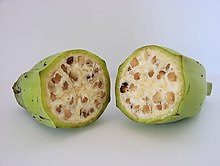Wild type

Than wild-type , in plants and animals also sometimes referred to as wild-type , in which is genetics a living being referred whose genome is present in a state as naturally by the evolution has arisen. The term is used both for the entire organism and for individual genes . The latter is referred to as the wild-type allele (s); Alleles deviating therefrom are referred to as mutant alleles and the organisms as mutants . When the mutants reach a significant proportion in the population, it is called polymorphism .
Non-wild types arise through mutation . Alleles that do not correspond to the wild type are found to be low in nature. In most cases they are recessive and can therefore often only show up in the phenotype if they are homozygous . If one crosses relatives with each other ( inbreeding ), these alleles become visible more often because the offspring of both parents can inherit the recessive mutated gene. Disadvantageous mutations often arise spontaneously, but would die out under natural conditions. In contrast, such mutations are often retained under laboratory conditions or in domestic animal breeding because they are further bred in a targeted manner.
Problems in defining a wild type often exist with species that do not occur freely in nature, such as B. Corn . Here, a certain variety is usually specified as the wild type in an experiment.
There are variations of this term depending on what is being researched. When researching the genetics of different skin and coat colors of animals and plants, the wild type is called wild-colored .
literature
- Elisabeth Günther: Outline of Genetics , 2nd edition, Gustav Fischer, Stuttgart 1971.